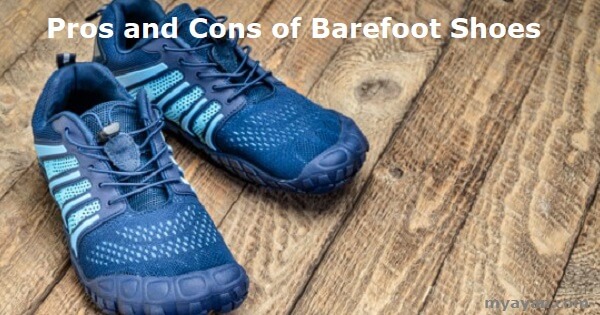Minimalist shoes, commonly called barefoot shoes, are intended to simulate the sensation of walking barefoot while offering some foot protection. Following are some possible benefits and drawbacks of wearing barefoot shoes.
Barefoot footwear gives the ground a more natural feel, which helps enhance balance and proprioception (the body's capacity to detect its location in space).
in the feet and legs to work harder, which might result in greater strength and stability because they have less cushioning and support.
As barefoot footwear permits greater foot movement, it promotes a more natural gait (walking or running pattern).
By encouraging a more natural foot posture and motion, barefoot shoes may help lower the risk of certain foot problems, including plantar fasciitis and Achilles tendonitis.
Barefoot shoes provide very little foot protection, making them inappropriate for trekking on rough terrain or playing contact sports.
These are more likely to occur if you wear shoes instead of bare feet, which might increase your chance of getting scrapes, bruises, and puncture wounds.
Your feet and legs may need some time to wear barefoot shoes, which may cause discomfort or damage. Not appropriate for everyone. Those with certain foot ailments or disorders, such as flat feet, high arches, or stress fractures, may be unable to use barefoot shoes. If you have any worries about the health of your feet, it's crucial to speak with a healthcare provider before experimenting with barefoot footwear.
Barefoot footwear may be wise for people who want to increase their balance, build stronger foot and leg muscles, and encourage a more organic stride. Before choosing to wear them, it's crucial to consider the potential benefits and drawbacks and speak with a healthcare provider.
Conclusion
There are benefits and drawbacks to wearing barefoot shoes. They can support a more natural stride, develop the foot and leg muscles, and aid with balance and proprioception.
However, they provide just a bare minimum of foot protection and might raise the risk of some injuries, particularly during adapting. When selecting whether to wear barefoot shoes, it's crucial to consider your unique demands and foot health. You should also speak with a healthcare practitioner if you have any questions.

These are some disadvantages despite their benefits:Requires vigilance and adjustment. To prevent damage, it takes time and effort to get your body used to wear minimal shoes.Shoe smell. They're not going to smell like fresh air and roses after a few times of barefoot jogging in them.
Your ankles get stronger when wearing barefoot footwear, which is excellent for control and stability. Also, strengthening the muscles in your feet promotes better posture and lowers your chance of future injuries because many knee and hip ailments start with a collapse of the feet.
Even though these shoes appear to be comfy, they eventually cause muscle atrophy and weak foot muscles. Many health problems, including joint discomfort, poor circulation, migraines, and sleeplessness, can be worsened.
It turns out that walking barefoot causes the knee to experience the least amount of joint stress. Unlike bigger, more cushioned siblings, minimalist shoes that mimic barefoot use have been demonstrated to minimise knee joint stress by 8%. Walking barefoot puts less strain on the knee than walking in shoes.
Just run barefoot/minimal for the first three months, every other day. You can continue running in your previous shoes or orthotics for the remainder of your running session if you want to. You may gradually reduce the amount of time you spend in supportive shoes until you no longer need them as you gradually increase your barefoot/minimal time.